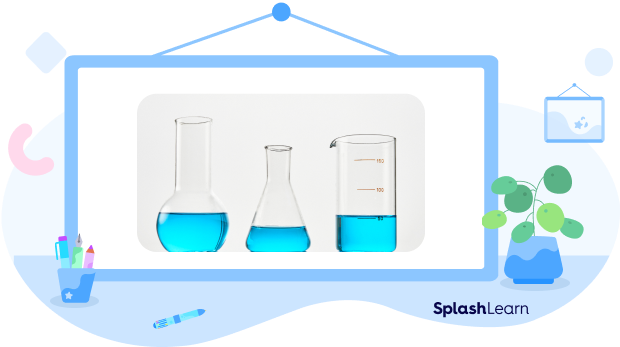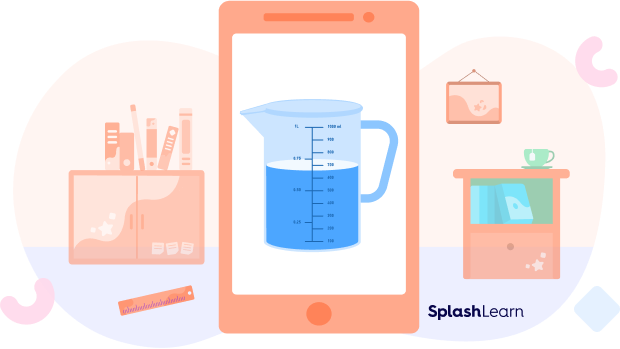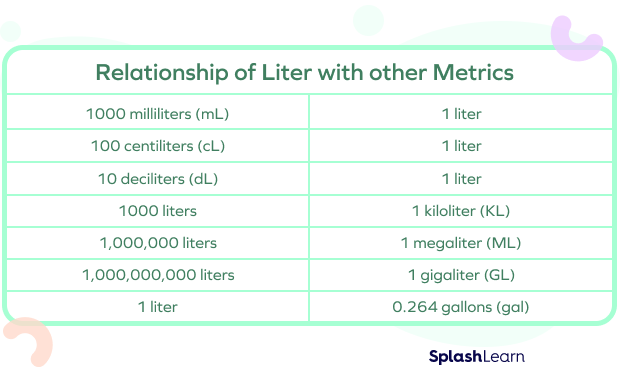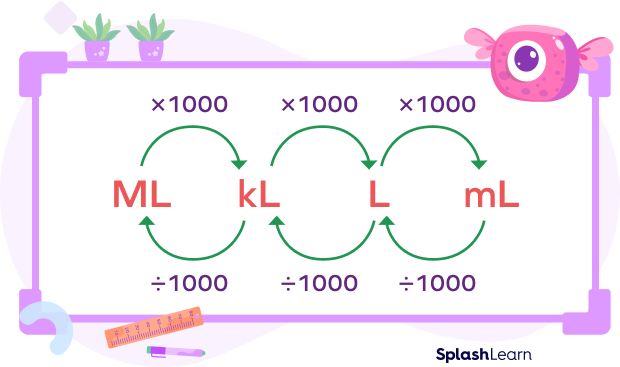What is Liter in Math?
Liter is a unit of volume and capacity in the metric system. Liquids are measured in volume. The volume of a liquid is the amount of space it takes up in a container, whereas the capacity is the total amount of liquid that can be contained in a container.
Definition of Liter
A liter is a metric unit of volume primarily used to measure liquids. The abbreviation of a liter is “L” or “l”. Smaller quantities of liquid are measured in milliliters (mL). 1 liter is equal to 1000 milliliters.
What Can We Measure Using the Unit Liter?
We usually measure solid weights using units like pounds, ounces, grams and kilograms. We measure liquids or fluids using volume, which is measured in Liters.
So, what can we measure in liters? The water you drink, the petrol you fill in your car, the oils you use, the milk that you drink, etc.

Why Do We Use Liter to Measure Liquid?
Let’s take three containers of different shapes and fill them with water. Can you tell which container has more water?

It is not possible to decide which container has more water just by looking at it. We need to measure the water in all the containers and express it in the same unit. That standard unit of measuring liquid is called a liter.
Liquids such as water, milk, petrol, and oil are measured in liters, milliliters, centiliters, kiloliters, etc.
What Is a Milliliter?
A milliliter is a smaller metric unit that measures the capacity of a liquid. It is used to measure smaller quantities of liquid, such as medicinal liquids. The abbreviation of a milliliter is mL.

Observe the water jug in the image above. It can hold 1 L of water. But the jug also contains smaller units of measurement, and the water in it can be measured in milliliters.
Liters to Milliliters Conversion
We know that 1 liter is equal to 1000 milliliters. So, to convert liters into milliliters, we have to multiply by 1000.
Let’s say you want to convert 5 liters into milliliters. So, 5 L
Similarly, 4, 6, and 8 liters are equal to 4000, 6000, and 8000 milliliters.
So it must be clear by now that to convert liter into milliliters, you just have to add three zeros to the right of the number.
Milliliters to Liters Conversion
To convert milliliters into liters, you have to take the opposite route. You will have to divide the given quantity of milliliters by thousand.
Let’s say you want to convert 8000 milliliters into liters.
So, 8000 mL
Similarly, 4000, 6000, and 7000 milliliters are 4 L, 6 L, and 7 L.
Relationship of Liter with Other Metrics


Solved Examples
Example 1: Siri purchased 3 cans of apple juice of 1 L each. She drank 1500 mL of juice. How much juice is left with her?
Solution:
Siri purchased 3 cans of apple juice of 1 L each. So, the total mL of juice with Siri is
Out of 3000 mL of juice, Siri drank 1500 mL.
So, the total mL of juice left with Siri is 3000 mL
Example 2: Jack bought 4 empty jars to fill with milk. Each jar can hold 2 liters and 250 milliliters of milk. How many liters of milk does he require to fill all 4 jars?
Solution:
First, let us determine how many milliliters of milk each jar can hold.
Given, 1 jar
or, 1 jar
So one jar can hold 2250 milliliters. Then, 4 jars can hold
Now, let’s convert 9000 milliliters into liters.
9000 ml
Therefore, Jack requires 9 liters of milk to fill all 4 jars.
Example 3: A diesel tanker can hold 5000 liters of diesel. Find out the gallons of diesel that the tanker can hold.
Solution:
The diesel tanker can hold 5000 liters of diesel.
We know that 1 liter
So, 5000 liters
Therefore, the tanker can hold 1320 gallons of diesel.
Practice Problems
Liter in Math – Definition with Examples
What do you get when you add 5 liters 860 milliliters and 8 liters 550 milliliters?
5 liters 260 milliliters
8 liters 550 milliliters
Total
Convert 5840 milliliters into liters.
5840 mL
The capacity of a jug is 500 mL, and the capacity of a bottle is 0.5 L. Which container has more capacity?
1000 mL
500 mL
Jane bought 2 liters of petrol. She used 150 mL of it. How much petrol does she have left?
2 litres
Remaining petrol
Frequently Asked Questions
Is liter the SI unit of volume?
The liter is not an SI unit. The SI unit of volume is the cubic meter.
From where was the term “liter” originally derived?
The term liter is derived from the traditional French unit of measurement, “litron.” The term litron came from Greek and was originally regarded as a unit of weight, not volume.
Are liter and quart the same?
A liter is a little bit more than a quart. Specifically, 1 liter is equal to 1.0567 quarts.
















